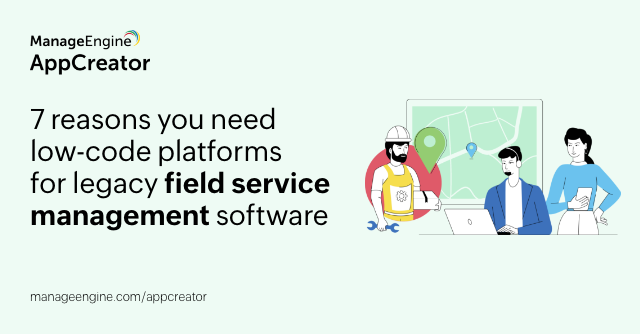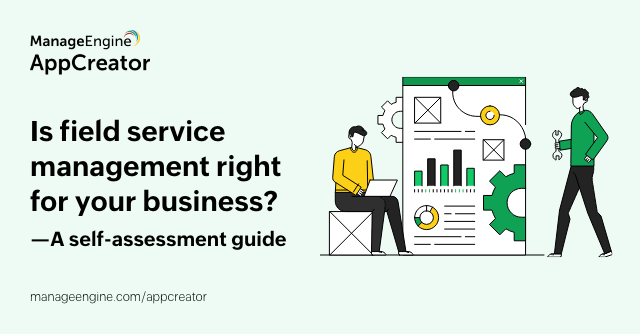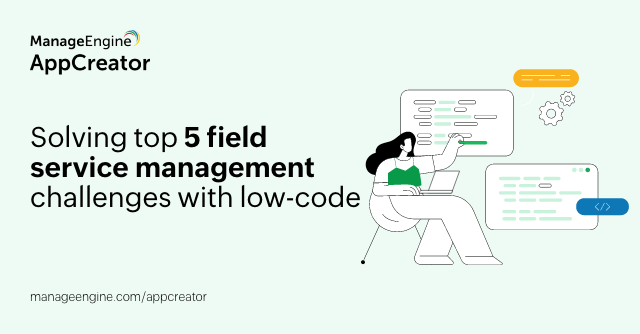Leveraging low-code platforms for GRC in IT
- Last Updated: September 20, 2024
- 15 Views
- 6 Min Read
An effective governance, risk, and compliance (GRC) approach is vital in IT organizations today. A robust GRC framework enables an IT organization to:
Govern itself with clear, well-defined, established standards and policies.
Effectively manage, mitigate, and deter risks that arise during operations.
Comply with global and industry standards seamlessly.
Approaches to implement GRC in IT organizations
Using off-the-shelf software
This software, typically called GRC tools, is readily available on the market. It ships with a set of prebuilt modules using which GRC can be implemented. The advantages of using these tools are that they are readily available and are quick to set up and use. The disadvantages of GRC tools are that you cannot customize them as per your unique business requirements, and you are locked to the vendor you purchased the software from for features and support.
Building GRC modules from scratch
This method entails enlisting the help of software developers or software development organizations to implement GRC from scratch for an organization.
Advantages of this approach:
1. You get a fully custom GRC solution.
2. You can make modifications at any time to your GRC modules.
Disadvantages of this approach:
1. It is expensive: Software developers and software development houses are expensive to enlist.
2. It is time-consuming: Building GRC software solutions from scratch takes a lot of time.
Leveraging low-code platforms
Going the low-code route is becoming increasingly popular in contemporary times.
Low-code platforms facilitate engineering solutions with minimal coding. On these platforms, a visual drag-drop-and-build approach is used to engineer applications and automate business processes.
The versatility of low-code platforms allows them to be harnessed for implementing GRC frameworks. Also, there are GRC-enabling low-code platforms like ManageEngine AppCreator which provide a basic skeletal GRC framework which can be granularly customized to suit an organization's needs. This saves time and money, and it also empowers GRC subject matter experts.
Advantages of leveraging low-code for GRC:
You get custom solutions at a fraction of the cost when compared to building GRC solutions from scratch.
GRC subject matter experts who have limited technical expertise can engineer GRC modules with ease.
Leverage rapid deployment of GRC when compared to traditional off-the-shelf software.
Disadvantages of leveraging low-code for GRC:
A small learning curve is associated with low-code platforms.
As most low-code platforms are Software as a Service, a recurring subscription is usually involved.
GRC using low-code
In the next section, we'll analyze how each component of GRC and GRC processes can be implemented individually using low-code platforms. We'll also take a look at how a holistic GRC program can be sustained using a well-thought-out GRC strategy.
Governance
Effective governance according to stringent organizational policies can be guaranteed using low-code platforms. Regulatory requirements need to be adhered to. Internal audit management, adherence to industry and government regulations, and constant streamlining of business processes are always a priority.
Workflow automation
Repetitive workflow processes when executed manually consume a lot of manpower, time, and money. By automating these workflow processes, low-code platforms assist in their standardization and efficient execution.
For instance, an approval process that involves a lot of paperwork can be automated using low-code to be instantly routed to all stakeholders, even alerting them about the process through email and mobile alerts.
Organization-wide collaboration and instant communication
By providing an interface for stakeholders to get instant updates about organizational processes, the turnaround times for business process execution are drastically reduced. Low-code platforms also empower stakeholders to collaborate amongst themselves through easy-to-navigate collaboration dashboards. This type of collaboration was hitherto not possible using paperwork.
Granular access control
Deciding who accesses which modules can be granularly controlled using low-code platforms. This promotes data integrity and security by ensuring that only those with relevant access privileges can access the corresponding GRC modules.
Data governance
Low-code platforms facilitate end-to-end data governance. Data cleansing, data validation, and data quality checks can be enforced. This allows governance with data integrity.
Risk
The need to mitigate risks, including business risks, is important. From identification, classification, and mitigation to forensic risk analysis, low-code platforms can be harnessed to tackle risks uniquely when compared with traditional risk management approaches. Enterprise risk management is vital from a sustainability perspective, avoiding third-party risk management by having an in-house dedicated risk management framework is essential for data integrity, and compliance risk management is also essential. Stakeholders need to have all the tools necessary at their disposal for risk management and risk assessment.
The risk life cycle
1. Risk identification
This process involves identifying the risk. Interactive dashboards for the GRC system can be quickly built using drag-and-drop interfaces offered by low-code platforms. In these dashboards, when certain preset conditions occur—for example, a KPI deviation—it indicates that something is not functioning as intended, and it requires additional investigation or analysis. This enables the GRC system to signal the presence of a risk and alerts stakeholders so they can perform the steps needed to alleviate it.
2. Risk classification
Low-code platforms can be used to create workflows that automatically classify risks based upon preset criteria. These are risk classification models. Stakeholders view these risks, sorted by parameters such as their severity and impact, priority, type, and technical heuristics, through a unified dashboard built using low-code visual builders.
This thorough risk classification aids in risk resolution.
3. Risk mitigation
Risk identification and classification aid in risk mitigation. Low-code risk mitigation workflows include workflows to:
i) Suggest a course of action to address the risk based upon its classification.
ii) Assign stakeholders and specify responsibilities.
iii) Set target dates for risk resolution.
iv) Implement risk response steps.
4. Risk forensics
Once a risk has been dealt with, then comes the process of risk forensics.
The steps in risk forensics are:
i) Incident creation and management for manifested risks
ii) Data collection
iii) Root cause analysis
iv) Identification of the vulnerabilities and subsequent patches
v) Risk documentation, or chronicling the risk's life cycle
vi) Review and feedback
Risk forensics aids in the generation of actionable data, which can be used as lessons and insights for risk management teams in the future. Effectively managing risks is crucial for organizational viability.
Compliance
Legal and regulatory requirements need to be addressed, and establishing viable compliance objectives is instrumental in maintaining compliance. Low-code platforms can be leveraged for holistic compliance management in organizations. The GRC software used needs to reliably achieve compliance objectives. Regulatory compliance ensures that the organization is on equal footing with industry regulations.
Streamlined stakeholder communication
Compliance activities mandate the synchronized collaboration of all stakeholders while also requiring instantaneous stakeholder communication. By facilitating multichannel communication through custom-built modules and web portals, low-code platforms facilitate streamlined stakeholder communication. This in turn reduces turnaround times and promotes organizational efficiency.
Agile adaptability
Changing times mean changing compliance laws and regulations. With their flexibility, low-code platforms can be used to engineer agile and adaptable solutions to tackle the new clauses introduced in compliance laws and regulations effortlessly.
Compare this with other options, such as off-the-shelf software or custom solutions, where adherence to compliance modifications takes ages to take effect.
Compliance workflow automation
Industry standards and regulations, such as the GDPR, the CCPA, HIPAA, necessitate automation of repetitive tasks that facilitate conformation to them. Low-code platforms can be leveraged to create workflows and custom solutions to automate tasks in these repetitive compliance endeavors. Once automated, these processes can be executed in very short periods of time, greatly increasing the organization's throughput. In comparison with manual compliance workflow execution, workflow automation using low-code platforms for compliance saves time, reduces manpower required, and allows teams to focus on the essentials instead of being bogged down by the mundane.
The way ahead using low-code platforms
Low-code platforms are proven to be capable of reducing turnaround times and increasing organization-wide efficiency. Utilizing them to enforce GRC in an organization reaps manifold benefits for all pertinent stakeholders. The reduced turnaround times, costs, and manpower utilization of low-code platforms make them a stellar candidate to enforce GRC in contemporary organizations. Also, aligning to business objectives is easy with low-code platforms.
If you're looking for a low-code platform to enforce GRC in your organization, you can evaluate the ManageEngine AppCreator platform. Sign up for a free, personalized demo here.



